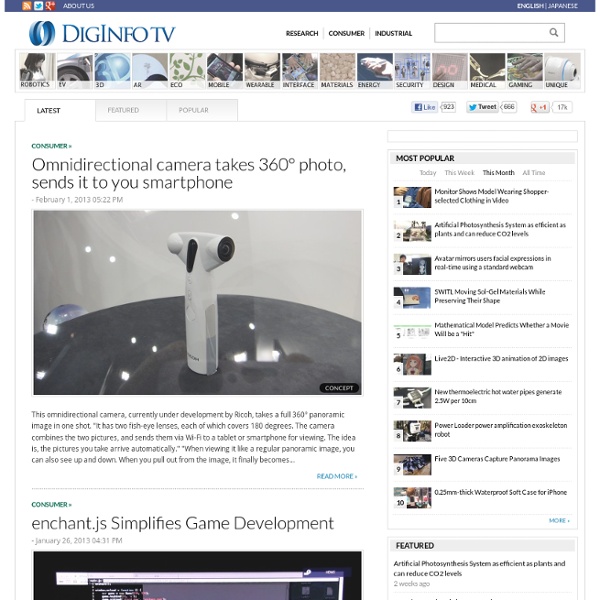



Science and technology research news | R&D Projects « Prev | 1 | 2 | 3 | 4 | 5 | 6 | 7 | 8 | 9 | 10 | Next » Detecting corrosion and fatigue during service A new project, CORFAT (Cost effective corrosion and fatigue monitoring for transport products SCP7-GA-2008-218637), looks to develop new monitoring technology based on acoustic emission testing (AT) combined with follow-up NDT (non-destructive testing) to detect defects such as corrosion or cracks in the structure of surface transport products (ships, railway tank cars, road tankers). Projects talks to Andreas Jagenbrein about predictive maintenance and what this means for transport safety. Read more » Human microbiota interactomics and multidisciplines The human body contains around ten times as many bacterial cells than it does human cells, and this gut microbiota provides the body with many useful metabolic functions. Read more » Computing the cure Read more » Tackling Quantum’s Classic Riddles Read more » Biosensing device research: the benefits of working together Read more » Read more »
OLPC : une tablette tactile à moins de 100 dollars L'association One Laptop Per Child (OLPC) avait participé aux premiers instants de la mode des netbooks avec son ordinateur éducatif et bon marché Xo, destiné aux élèves des pays en développement. Elle a maintenant un nouveau projet dont nous vous avons déjà parlé : une tablette éducative. Alors que l'iPad arrive dans les rayons, OLPC a annoncé qu'un premier modèle qui coutera moins de 100 $ sortira l'année prochaine, construite en collaboration avec Marvell. Ce modèle sera basé sur la tablette Moby de ce constructeur, personnalisée pour l'OLPC et tournant à terme avec leur version de Linux dans un environnement Sugar & Gnome (si leur OS n'est pas prêt, la tablette utilisera probablement Android en attendant). Mais le projet Xo-3 en plastique et rechargeable à la main, destiné aux pays en voie de développement, est maintenu. La tablette Moby : Le projet Xo-3 : La tablette remplace le projet Xo-2, composé à l'époque de deux écrans dont un tactile.
Opinions Libres, le blog d'Olivier Ezratty The Verge les éditions volumiques Accelerating Future There isn’t enough in the world. Not enough wealth to go around, not enough space in cities, not enough medicine, not enough intelligence or wisdom. Not enough genuine fun or excitement. Not enough knowledge. What we need is more . There is a bare minimum that we should demand out of the future. 1) More space 2) More health 3) More water 4) More time 5) More intelligence First off, we need more space . There is actually a lot of space on this earth. QuickTime - WWDC 2010 Keynote Address TechCrunch Tech Home The Bacon | We Don't Push Kilos, We Move Ones And Zeros Keepintouch-blog Keepintouch-blog | Le blog des surfaces interactives PLoS Biology : Publishing science, accelerating research A Peer-Reviewed, Open Access Journal Current Issue PLOS Biology is a peer-reviewed, open-access journal featuring research articles of exceptional significance in all areas of biological science, from molecules to ecosystems.
FRANCE 24 lance la transcription automatique sur son lecteur vid Le LAB, le pôle Recherche & Développement de FRANCE 24, lance en partenariat avec Yacast Media, Exalead et Vecsys, une nouvelle fonctionnalité sur son lecteur vidéo haut débit permettant de transcrire automatiquement sous forme de texte les 24 dernières heures d’antenne. Depuis décembre dernier, FRANCE 24 propose sur son site Internet une nouvelle expérience de télévision interactive : le lecteur HD. Ce lecteur haut débit offre aux internautes la possibilité de « contrôler le direct », car il peut balayer les 24 dernières heures de programmes en quelques secondes, en déplaçant le curseur sous l’image sur un simple navigateur web. Fort de cette innovation, le LAB de FRANCE 24 fait aujourd'hui évoluer cette application en y ajoutant une nouvelle fonctionnalité permettant de faire figurer automatiquement sur ce même lecteur chaque mot prononcé à l’antenne, depuis les commentaires des présentateurs, les récits de reportages jusqu’aux interviews de tous les invités.